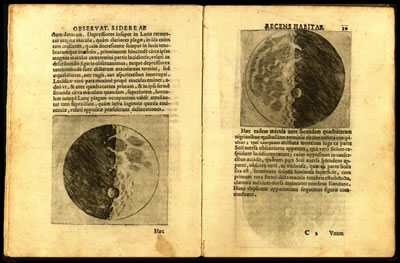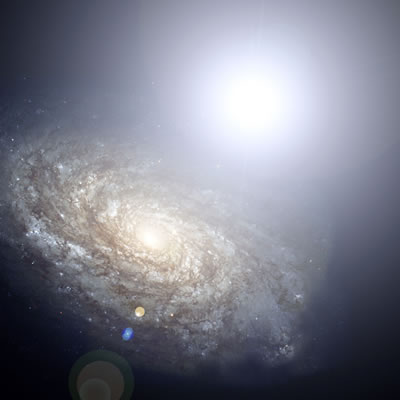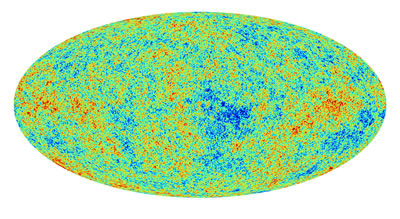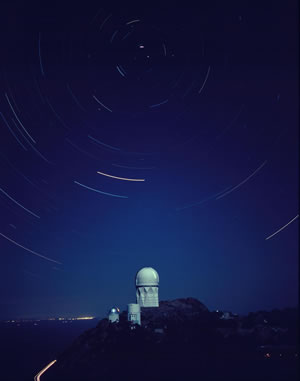Astronomy, Astrophysics, Cosmology: 400 Years of a Changing Universe
By Paul Preuss
Galileo Galilei, a most humble servant of Your Serene Highness ... now appears before You with a new contrivance of glasses, drawn from the most recondite speculations of perspective, which render visible objects so close to the eye and represent them so distinctly that those that are distant, for example nine miles, appear as though they were only one mile distant.
-- Galileo
Imagine! A contrivance of glasses that can make an object nine miles away appear as if it were only one mile distant! Galileo made this claim in a job application to the Doge of Venice. Sure enough, he got the job.

In 1610 Galileo announced his telescopic observations of Earth’s moon and his discovery of the moons of Jupiter in The Starry Messenger, Sidereus Nuncius in Latin, a popular and accessible work (for those who could read Latin, anyway) that launched the first Copernican revolution.
Galileo didn’t invent the telescope, but he markedly improved it; even better, not only was he one of the greatest physicists of all time but one of the greatest science communicators. After he found mountains on the moon late in 1609 and the moons of Jupiter early in 1610, he promptly published his discoveries in a brilliantly titled best-seller, The Starry Messenger.
The result was a revolution in thought. These and Galileo’s subsequent observations were not the first experimental support for the Copernican theory – which placed the sun, not the earth, at the center of the heavens – but they were by far the most persuasive evidence, and the most widely disseminated. They caught the public’s imagination and got the message across: it seemed that in designing the universe, God had had a few other things to think about besides us geocentric, egocentric humans.
In 1611 Galileo joined Rome’s Accademia dei Lincei, “Academy of the Lynxes,” Italy’s and the world’s first academy of sciences. The Lincean Academy stood by Galileo when he got in deep trouble with the Catholic Church but languished after its wealthy founder died; four centuries later, it has been reincarnated more than once and now serves Italy much as the National Academy of Sciences does the United States.
The modern Accademia Nazionale dei Lincei also gives awards for scientific achievement – including, once every five years, the International Antonio Feltrinelli Prize in the Physical and Mathematical Sciences. Its most recent recipient is Berkeley Lab astrophysicist Saul Perlmutter.
“It's certainly an honor to be recognized by the Academy whose namesake institution championed Galileo,” said Perlmutter when the award was announced. “In Galileo's time, studies like the acceleration of gravity and the positions of the sun and planets in space must have seemed utterly impractical. Yet it's only by tackling such abstract questions that we've been able to make scientific progress.”
Perlmutter is at the forefront of a revolution as profound as the Copernican. In the 1980s and 1990s the Supernova Cosmology Project, which he leads, used methods they had devised and tested for years to find certain kinds of exploding stars called Type Ia supernovae, with which they planned to measure the expansion of the universe.
Type Ia supernovae are among the brightest objects in the cosmos, visible across vast distances; although they’re fleeting and unpredictable, by photographing thousands of distant galaxies at a time and photographing the same galaxies again a few weeks later, it’s virtually certain that several supernovae will have appeared in the meantime.
In 1994 a rival group, the High-Z Supernova Search Team, saw that the SCP’s methods for finding “supernovae on demand” worked and would soon result in valuable new data about the cosmos; they adopted the SCP’s methods and raced to get the answers first.
Just as important as their brightness, Type Ia supernovae are all nearly the same brightness. Thus they make ideal “standard candles” for precisely measuring how far away and how long ago (since light takes time to travel) they exploded. How much the universe has expanded since the explosion is shown by how much the supernova’s spectrum has shifted toward the red. Comparing redshift and distance reveals how fast the universe is expanding, and whether it’s expanding steadily or starting to slow down.

Type Ia supernovae are brighter than whole galaxies and visible billions of light-years away. The Supernova Cosmology Project devised ways of finding Type Ia supernovae “on demand,” then measured the expansion of the universe with a precision that led to the discovery of dark energy.
In January of 1998 Perlmutter, representing the Supernova Cosmology Project, was first to announce what both rival teams had discovered, to their mutual astonishment: the expansion of the universe isn’t slowing down and it’s not coasting. It’s accelerating.
What could be pushing all the stars and galaxies apart? In 1916 it was thought that our galaxy was the whole universe, static and unchanging. To keep things that way, Einstein had introduced a “cosmological constant” into his General Theory of Relativity, a mathematical term that could be dialed to balance the gravitational equations so that they represented a Milky Way that neither expanded nor contracted.
It wasn’t long before Edwin Hubble, using telescopes at the Mount Wilson Observatory high in the mountains above the Rose Bowl, showed that the universe contains uncountable galaxies besides our own, and they’re all moving away from each other; the farther they are, the faster they’re receding from us. Einstein ditched his cosmological constant, thinking it an inelegant patch; if the universe isn’t stable, who needed it?
What Perlmutter and his colleagues showed in 1998, however, was that the cosmological constant – or something a lot like it – is a real physical phenomenon. Today, to allow for various possibilities, we call this phenomenon dark energy.
Prelude to revolution
In 1992, a few years before the discovery of dark energy, Berkeley Lab cosmologist George Smoot had also found features in the sky that helped rewrite the history of the heavens. These were so-called anisotropies in the cosmic microwave background radiation (CMB) – or, as Smoot put it more poetically in his book about the find, Wrinkles in Time.
The time in question was 300,000 to 400,000 years after the big bang, when radiation and particles – which had been entangled, filling the universe like a bowl of opaque soup – abruptly cooled enough to part company and go their separate ways. The universe has continued to expand and the radiation has continued to cool; it now fills the sky with a uniform background, detectable by radio receivers in the microwave region of the spectrum.
Before the universe became transparent, however, the soup was vibrating with pressure waves in a regular pattern of greater and lesser density. Small differences in the temperature of today’s background radiation, only a ten-thousandth of a degree Kelvin, marked the regions where matter was more or less dense. Gravity concentrated the denser regions, and eventually they coalesced into the seeds of the galaxies we see today.
First measured by Smoot’s instruments aboard the Cosmic Background Explorer satellite (COBE), these observations earned Smoot a share of the 2006 Nobel Prize in physics. Berkeley Lab scientists have continued to measure the cosmic microwave background to probe the nature of the universe. In 1998 the balloon-borne BOOMERANG and MAXIMA experiments made what were then the highest-resolution measurements of variations in the CMB, achieved by scanning small patches of the sky to gather unprecedented volumes of data.
The results confirmed that the universe is geometrically flat, as predicted by the theory of cosmic inflation. Taken together, the Supernova Cosmology Project’s discovery of the accelerating universe and the CMB’s proof that the universe is flat gave rise to a new “concordance cosmology”: although nobody really knows what dark energy is, we do know that it accounts for three-quarters of everything in the universe. Dark matter, whose nature we’re also unsure about, accounts for most of the rest. Ordinary visible matter, and the forces that hold it together, make up less than five percent of the universe. Not only are humans not at the center of the universe, we’re not even made of the same stuff as most of it.

The Planck satellite’s map of the cosmic microwave background will encompass more of the sky at a higher resolution than any CMB map ever made, opening a window on the early universe and shedding light on how the universe has evolved in unprecedented detail. (Image credit European Space Agency)
Julian Borrill, co-leader of the Lab’s Computational Cosmology Center with supernova researcher and fellow astrophysicist Peter Nugent, has headed the analytical team for much of the CMB data at the National Energy Research Scientific Computing Center (NERSC), including that of the U.S. participation in the European Space Agency’s recently launched Planck satellite. He phrases the new Copernican predicament in another way.
“As things stand,” Borrill remarks dryly, noting that no one understands the nature or origin of either dark matter or dark energy, “we have quantified our ignorance to be at the 95-percent level.”
Why spectroscopy matters
Supernovae remain the most dependable means of measuring the expansion history of the universe. The accuracy of supernova measurements promises to improve dramatically owing to recent advances by the Nearby Supernova Factory (SNfactory) which, like the SCP, is an international collaboration based at Berkeley Lab. One of the SNfactory’s key instruments is the Supernova Integral Field Spectrograph built by the SNfactory’s French partners, installed on the University of Hawaii’s 2.2 meter telescope on Mauna Kea.
In the unmatched library of spectra developed by the SNfactory, team member Stephen Bailey discovered an efficient method for standardizing the intrinsic brightness of Type Ia supernovae. Simply by measuring the ratio of the brightness between two specific regions in the spectrum of a Type Ia supernova taken on a single night, that supernova’s brightness – and thus its distance – can be determined to better than 6 percent uncertainty.
Cosmologist Greg Aldering, who leads the SNfactory, says, “This is an example of exactly what we designed the Nearby Supernova Factory to do. It underlines the vital role of detailed spectrometry in discoveries of cosmic significance.”
But supernovae – and their spectra – aren’t the only route to investigating dark energy. Berkeley Lab astrophysicist David Schlegel heads up an effort called the Baryon Oscillation Spectroscopic Survey, or BOSS, a dark energy measurement that’s completely independent of supernova studies.
Schlegel’s interest in dark energy is ironic considering that he admits, “To tell the truth, the first time I heard about dark energy I was skeptical.” But that was before he considered the possibilities of a new kind of dark energy measurement.
Translated into plain language, baryon acoustic oscillation (baryon is shorthand for matter), or BAO, simply means that the density of matter in the universe, including galaxies and quasars, varies regularly and bunches up roughly every 500 million light years.
If measured with sufficient accuracy, this periodicity can provide a natural yardstick for determining whether the universe has expanded smoothly since the big bang or whether the rate has varied. If smooth, then dark energy is indeed some form of unchanging cosmological constant. If the rate has varied, other explanations – such as “quintessence,” a dynamic form of energy that changes in space and evolves with time – would be favored.
A 500-million-light-year yardstick requires at least a few billion light years of space in which to deploy it. That’s why BOSS employs the Sloan Digital Sky Survey telescope in New Mexico, custom-designed to scan an enormous volume of space. With this telescope and thousands of hand-crafted “plug-plate” masks to zero in on preselected targets, BOSS will collect 1.5 million galaxies, plus up to 200,000 quasars at redshifts beyond the most distant supernova yet found.

The proposed BigBOSS baryon acoustic oscillation (BAO) survey would make use of the Mayall 4-meter telescope at Kitt Peak National Observatory in Arizona and its sister telescope at Cerro Tololo Observatory in Chile to probe dark energy with 50 billion galaxies and quasars, rivaling the BAO survey proposed by JDEM at lower risk and cost. (Photo credit NOAO/AURA/NSF)
If Schlegel and his colleagues have their way, that’s just the beginning. In April of this year they proposed BigBOSS, a collaboration between the U.S. Department of Energy (DOE) and the National Science Foundation that would extend baryon oscillation surveys far deeper in space and back in time, using automated methods to survey as many as 50 million galaxies and quasars over a ten-year period, using the 4-meter Mayall telescope on Kitt Peak National Observatory in Arizona and a sister telescope at the Cerro Tololo Inter-American Observatory in Chile.
Implications for a meaningful satellite mission
What makes BigBOSS particularly interesting is that, so far as baryon acoustic oscillation is concerned, BigBOSS will be able to investigate dark energy as well or better than the proposed Joint Dark Energy Mission (JDEM), a space mission involving DOE but whose overall management is NASA’s responsibility.
NASA’s reference design for JDEM includes three different ways to measure dark energy: BAO, supernovae, and a complementary technique known as weak gravitational lensing, which measures the effect of dark energy on the growth structure of the universe by detecting minute distortions in the shapes of distant galaxies as their light passes through uneven distributions of matter.
Ironically, the Joint Dark Energy Mission was originally inspired by the SuperNova/Acceleration Probe satellite, or SNAP, conceived in 1999 by members of the Supernova Cosmology Project and their colleagues. Designed to collect thousands of distant Type Ia supernovae with a two-meter telescope and perform high-quality photometry and spectroscopy on every one of them, SNAP would also have measured weak lensing and baryon oscillation.
Unfortunately, the spectroscopy instruments in the present JDEM design would be inadequate for the kind of accurate supernova measurements originally designed for SNAP – and demonstrated to a high degree by the SNfactory’s recently devised flux-ratio method for standardizing Type Ia brightness. As for baryon oscillation measurements, NASA’s plan for JDEM emphasizes this approach. Nevertheless, the ground-based BigBOSS survey would do as well or better in a shorter time, at less risk, and at far less cost.
The discovery of dark energy has triggered the latest Copernican revolution in cosmology, but the revolution won’t be over until scientists determine the nature of dark energy. The best ways to do that remain a subject of lively debate. Berkeley Lab researchers have pointed the way since the Supernova Cosmology Project was founded in 1988 and did what many astronomers said couldn’t be done – measured the expansion of the universe with Type Ia supernovae. The SCP proved their point and inspired their competitors. Berkeley Lab researchers and their colleagues around the world have remained at the forefront of dark energy research.
Additional information
- Feltrinelli International Prize Awarded to Berkeley Lab's Saul Perlmutter
- Dark Energy's 10th Anniversary:
Part I, Announcing the accelerating universe
Part II, Success breeds competition
Part III, The aftermath: confirmation and exploration - George Smoot Wins Nobel Prize in Physics: The measurement of anisotropies in the cosmic microwave background radiation
- A Rising Tide of Cosmic Data: Simulating Planck’s focal plane and beyond
- Cosmology’s Best Standard Candles Get Even Better: A simple new method standardizes the brightness of Type Ia supernovae
- BOSS: the Baryon Oscillation Spectroscopic Survey: A unique way to measure dark energy with galaxies and quasars
- BigBOSS: The Ground-Based Stage IV BAO Experiment
- JDEM: A New Dawn for Dark Energy


